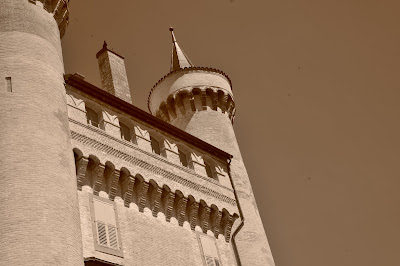

The Château of Vufflens stands on a hill overlooking Lake Geneva, near Morges. The imposing fortress represents the most striking example of a small group of castles in western Switzerland dating from the late Middle Ages. It is characterized primarily by the fact that it is built of brick. This impressive building consists of several elements.



The outer walls and other structures for the defense were victims of modern renovations. The complex of buildings stands in the agricultural field belonging to the castle, there must have been in the Middle Ages a large front yard, enclosed by a wall and probably including stables, barns and other common areas, as well as, the houses for the servants.



The foundation consists of three main elements: to the east, a main building with paneled corners; to the west a large tower built in the center of a quadrangular enclosure and flanked by towers; and a courtyard surrounded by a wall connecting the sides of the eastern and western ones. While in the past it was generally believed that the residential building dated from the early thirteenth century, we now attribute the whole fortress of Vufflens to the early fifteenth century. With its very high square turrets, the Western body shape clearly is the dominant element of Vufflens. Cave understood, it is the base of the six story roof and is over thirty feet high. The upper floor is abundantly provided with machicolations and battlements. A turret protruding half out of the tower houses towards the staircase which connects all floors.


It seems already around the year 1000, the Kingdom of Upper Burgundy possessed near Vufflens - la- Ville, Southern Cossonay, an important area which they gave as a gift to the abbey of Romainmôtier (see entry Aux Pieds du Jura). This domain had been administered by members of a noble family in the region engaged by the abbey as stewards. Around 1100, the family was divided into two parts: one retained the privilege to extinction, that is to say until the thirteenth century, the other founded over Morges Fortress Vufflens. We do not know what was the aspect of this first work, built around 1100. The family named for the first time in a document dating from the mid-twelfth century, referring to Peter Vufflens, took great pains to win against the powerful local aristocracy, which sought to create autonomous territorial lordships. In 1175, William Vufflens beholden his castle and manor to the bishop of Lausanne, but he did not retain long his rights, as they passed in the early thirteenth century already to the hands of the counts of Genevois. In turn, they conceded to the lordship of Lords Vufflens Cossonay; the original owners of the castle and Vufflens were lowered to the level insignificant vavasours. Favorable to the counts of Genevois, they supported them in the struggle that pitted Peter of Savoy and sought possession of Vaud. The Cossonay however, were not big enough to be measured by the Savoyard and they finally had to acknowledge his supremacy. To prevent the lordship of Vufflens from moving to the Savoy, the counts of Genevois arranged a marriage between the house of Vufflens, which endangered the lords of Duin their supporters. And indeed Vufflens returned to the mid-thirteenth century to the family Duin, but they switched sides after a short time and took up the cause of Peter II of Savoy. From that moment, the manor belonged to the Vufflens Savoyard house as a stronghold of Duin.


Functional Machicolations
History
It seems that around the year 1000, the Kingdom of Upper Burgundy possessed near Vufflens - la- Ville, Southern Cossonay an important area which which was given as a gift to the abbey of Romainmôtier. This domain has been administered by members of a noble family in the region engaged by the abbey as stewards . Around 1100 , the family was divided into two parts: one retained the privilege to extinction, that is to say until the thirteenth century, the other founded Morges Fortress Vufflens. We do not know what was the aspect of this first work, built around 1100. The family, named for the first time in a document dating from the mid-twelfth century, referring to Peter Vufflens, took great pains to win against the powerful local aristocracy, which sought to create autonomous territorial lordships. In 1175, William Vufflens beholden his castle and manor to the bishop of Lausanne, but he did not retain long his rights, as they passed in the early thirteenth century already in the hands of the counts of Genevois. In turn, they conceded to the lordship of Lords Vufflens Cossonay; the original owners of the castle and Vufflens were lowered to the level insignificant vavasours. Favorable to the counts of Genevois, they supported them in the struggle that pitted Peter of Savoy and sought possession of Vaud. The Cossonay however, were not big enough to be measured by the Savoyard and they finally had to acknowledge his supremacy. To prevent the lordship of Vufflens moves to the Savoy, the counts of Genevois arrangèrent a marriage between the house of Vufflens, endangered, and the lords of Duin their supporters . And indeed , Vufflens returned to the mid-thirteenth century to the family Duin, but it switched sides after a short time and took up the cause of Peter II of Savoy. From that moment, the manor belonged to the Vufflens Savoyard house as a stronghold of Duin.




Today the château is a private property.





The vineyards
No comments:
Post a Comment